
endangered
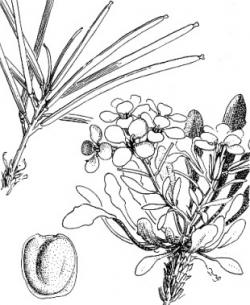
Illustration from Abrams (1944).
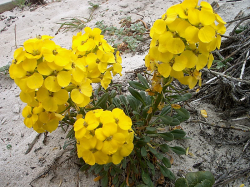
Photo taken at Pebble Beach © 2004 Bob Huettmann.
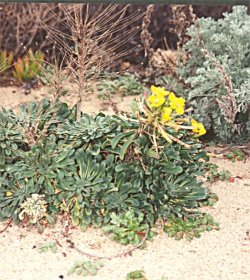
Photo taken at Marina State Beach © Dean W. Taylor.
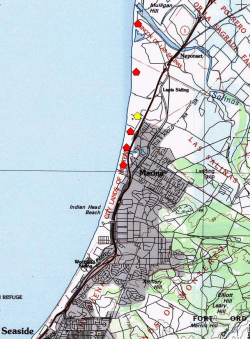
Occurrences of what has been referred to as Erysimum menziesii ssp. yadonii. A red polygon indicates an extant occurrence; yellow indicates the occurrence has been extirpated.
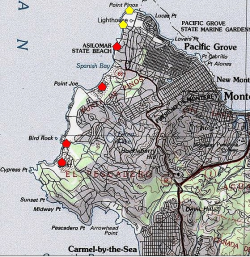
Occurrences of what has been referred to as Erysimum menziesii ssp. menziesii. A red polygon indicates an extant occurrence; yellow indicates the occurrence has been extirpated.



This fact sheet was prepared by Grey F. Hayes and Dean W. Taylor under award NA04N0S4200074 from the National Oceanic and Atmospheric Administration (NOAA), U.S. Department of Commerce (DOC). The statements, findings, conclusions, and recommendations are those of the authors and do not necessarily reflect the views of the NOAA or the DOC.
© Copyright 2006, Elkhorn Slough Coastal Training Program
Last updated: Feb 9, 2015 16:21
Common Names - Menzies's wallflower
Family - Brassicaceae (Mustard Family)
State Status - state endangered
(September 1984)
Federal Status - federal endangered
(June 1992)
Habitat
Coastal dunes (in our region), mostly on the seaward edge of stabilized fore-dunes; < 300 m.
Key Characteristics
Biennial or short-lived perennial herb to 2.5 dm tall, taprooted; basal leaves 5–15 mm wide, rosetted, spoon-shapped, entire to lobed, flat, tapered gradually to broad margined petioles that are often longer than the blades; inflorescence at first with the flowers dense and crowded (elongating in fruit), petals 15–30 mm long, yellow, claw 10–15 mm, style short and stout; siliques flattened parallel to the septum when dry; seed oblong, wing widest at tip (Al-Shehbaz 2013). Differs from E. ammophilum in its preference for more saline sites, shorter stem, spoon-shaped basal leaves, and obscure fruit valve midvein.
Flowering Period
March to June
Reference Populations
Asilomar State Beach, Bird Rock, 17-mile Drive, Marina State Beach, Marina Dunes Preserve (Monterey County).
Global Distribution
Endemic to central coastal California in the Monterey Bay region north to southern Oregon.
Conservation
Erysimum menziesii was treated by Price (1987, 1993) as four geographic subspecies (including E. concinnum), but the formal taxonomy was never validly published. The current Jepson Manual/eFlora treatment (Al-Shehbaz 2013) does not recognize these subspecies, however its listing status pertains to the species as a whole. Monterey Peninsula populations have been referred to E. m. ssp. menziesii, ined. (biennial, caudex unbranched, generally winter- or spring-flowering), while Marina dunes populations have been referred to as E. m. ssp. yadonii, ined. (often perennial, caudex branched, summer-flowering).
A 1987 population dynamics study (Berg 1986) indicated that though fecundity is high, there is naturally a high mortality of juvenile plants, and the seedbank does not appear to persist in the soil. If plants reach the rosette stage, however, they can persist for several to many years until conditions are right for flowering to occur. In their rosette form, they are quite susceptible to trampling, nor do they compete well with the non-native grasses (especially European beachgrass) and iceplant that have invaded their habitat. For this reason, weed removal appears to be highly beneficial, though follow-up monitoring is needed (USFWS 2008). Generally, it appears that Menzies's wallflower populations have the potential to sustain themselves if protected from human impacts (Berg 1986).
Occurrences in proximity to golf courses are being eliminated by vegetation change induced by artificial irrigation. Artificial occurrences have been planted at Spanish Bay and near Bird Rock, but are vulnerable to deer browsing and have not maintained the genetic integrity of sources. The four occurrences in the vicinity of the Marina dunes on Marina State Beach, Marina Dunes Preserve, and the Cemex Sand Plant property are threatened by recreation and direct and indirect effects of sand mining, including beach erosion. (USFWS 2008).
Plants were introduced at the Fort Ord Dunes State Park in the 1990s and habitat restoration has been conducted there and at Marina State Beach. Initial introduction results looked promising, but as of 2008, populations had declined (USFWS). Sand stabilization, along with timely rainfall, has been found to be an important factor in seedling success rate (Ferreira and Smith 1986).
References
Abrams, L. 1944. Illustrated Flora of the Pacific States, Vol. 2. Stanford University Press, Stanford, CA.
Al-Shehbaz, I. A. 2013. Erysimum menziesii, in Jepson Flora Project (eds.). Jepson eFlora, http://ucjeps.berkeley.edu/cgi-bin/get_IJM.pl?tid=25136 [accessed 8 February 2015].
Berg, K. S. 1986. Population dynamics of Erysimum menziesii, a facultative biennial mustard. Pp. 351-357, in T. S. Elias, ed. Conservation and management of rare and endangered plants. California Native Plant Society, Sacramento, CA.
CNPS, Rare Plant Program. 2013. Erysimum menziesii, in Inventory of Rare and Endangered Plants (online edition, v8-02). California Native Plant Society, Sacramento, CA. http://www.rareplants.cnps.org/detail/3665.html [accessed 8 February 2015].
Ferreira, J. and S. Smith. 1986. Methods of increasing native populations of Erysimum menziesii. Pp. 507-511, in T. S. Elias, ed. Conservation and Management of Rare and Endangered plants. California Native Plant Society, Sacramento, CA.
Price, R. A. 1987. Systematics of the Erysimum capitatum alliance (Brassicaceae) in North America. Ph.D. Dissertation, University of California, Berkeley.
Price, R. A. 1993. Erysimum, in J. C. Hickman, ed., The Jepson Manual; Higher Plants of California. University of California Press, Berkeley, California.
U.S. Fish and Wildlife Service (USFWS). 2008. Menzies wallflower (Erysimum menziesii) 5-year review: summary and evaluation. Arcata Field Office, Arcata, CA. http://www.fws.gov/arcata/es/plants/menziesWallflower/documents/Erysimum%20menziesii%205-yr%20CNO%20FINAL%202Jul08.pdf [accessed 8 February 2015].
